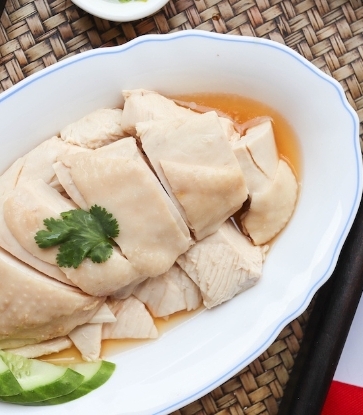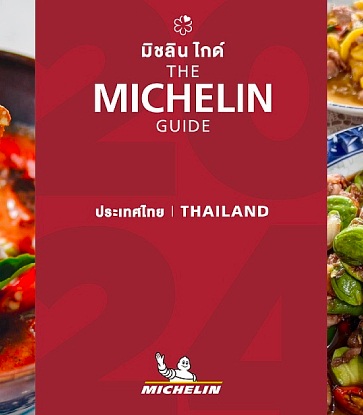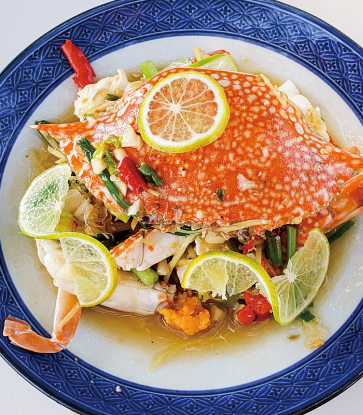Thailand’s old capital Ayutthaya is often associated with the three rivers running through it. So it makes sense that the idea of fresh, huge river prawns and other catches are a draw for foodies.
But did you know that another star of Ayutthaya cuisine is actually the land-locked roti sai mai (roti-wrapped candy floss)? This favoured snack among Thai Muslims has become part of Ayutthaya’s identity—so much so that no visit seems complete without grabbing a sweet set or two to take home as gifts.
And when it comes to the most famous stores for this offering, Roti Sai Mai Mae Pom (Bib Gourmand, MICHELIN Guide Thailand 2022) is one that many fans can only dream of. That’s because only the truly lucky can get their hands on this famed roti.

This humble shophouse has been operating for over 37 years. Customers, and wishful visitors, are sure to be met by one of the three family members—father, mother, and daughter—who work hard at their stations all day to run the business. Narongrit Nuchanart spins the sai mai, or candy floss, while his daughter, Chaweewan Nuchanart, takes up a hot pan to make the roti. Pornpun Samitamuksik, better known as Mae Pom (translated as Mother Pom), is in charge of packing products and handling customers.
Mae Pom shares that before claiming her roti sai mai name today, she worked as a government school teacher. But she enjoyed owning a business more, so she learned how to make roti sai mai from her sister’s boyfriend, who happened to have a Muslim background. She then started selling these sweet treats back when sugar only cost two baht per kg. Today, the price of sugar per kg has jumped to a whopping 30 baht.

“Back then, we sold our sai mai sets for only five baht. Now, prices have inflated to 50 baht per set. At first, it didn’t sell so well and wasn’t as popular as it is now, but we have continuously worked on improving the recipe. I hold the motto that if I do anything, I must make it the very best. I don’t stop until I am at the top. All work processes are on us. If you really study it and put in the effort, there’s nothing stopping you from getting to the top once you set your heart to it.”
Mae Pom recalls that when they first started out, the roti was not as soft and plush like it is today. But thanks to their determination, the family never gave up on improving their dough recipe. As the taste improved, their popularity grew, and people flooded in from all directions to have a taste of Mae Pom’s roti sai mai. It would have been hard to believe back then that they would receive such an overwhelming number of orders each day as they do now.

Those who have yet to have a taste may wonder, “It’s just roti sai mai, how good could it possibly be?” Let’s just say that throughout the day, an endless trickle of customers visit the store to pick up their goods that they’ve reserved in advance. Some have sent in their orders months ahead even. Some walk-in customers also stop by, hoping they’ll be lucky enough to nab a set to take home.
“Our regular customers have complained since we got the award from MICHELIN Guide. We were already selling well as it was, but after getting the award, our sales were just phenomenal. Normally, people just enjoy our food discreetly, but they haven’t gotten to eat much since the award from MICHELIN came along,” Mae Pom confesses.
“Some customers drop by to buy [our products] without making any advance orders. When they can’t buy anything, they get into a bad mood, and we have to deal with those reactions. Some nights we get so many orders that we’re just laying in bed stressing, wondering if we can produce enough in time. Sometimes when there are already so many orders, we just have to turn the phone off because we cannot possibly take on any more.”

With a household production base of only three people, only 10 pans of candy floss can be made each day. This amounts to a limit of 200 sets of roti sai mai per day. The meticulous process involves creating the roti dough, which consists of wheat flour, water, salt, and a touch of oil. Spreading that dough onto a hot pan requires immense expertise.
For the cotton candy, absolutely no stirring is to take place while simmering the sugar. What’s done instead is they shake the pan. The simmering goes on until the sugar turns an aromatic brown. After that, it is cooled, before it is mixed with a sugar separator, which is a perfectly blended oil and flour mix that is turmeric in colour. From then, the spinning of the candy floss follows, which may remind some of taffy pulling, but with a much different result. This labour-intensive step is one that requires much practice before expertise is formed.

“This work really requires patience. You can’t be hot-tempered at all. If I start to lose my temper, I have to stop immediately, or else the strands will break and be ruined. It’s something you have to do when you’re in a good mood, so the strands come out beautiful and delicate,” Narongrit and Mae Pom reveal their secrets to spinning perfect sugar floss.
This writer is like many others who wondered what the big fuss over this roti sai mai is. After all, there are hundreds of similar shops across Ayutthaya, but Mae Pom’s renown must really be something if people are on waiting lists stretching over many months. Once you’ve had a taste, even the sceptics will rejoice— the roti is deliciously thin, lush, chewy, and aromatic. The bits of sesame add even more charm and depth to the roti. The candy floss strands are delicate, with a gentle sweet taste that melts in your mouth. It is no surprise at all that Mae Pom’s popularity knows no bounds and sees month-long queues. It is also one of the few roti sai mai shops that gained the approval of our discerning inspectors and made it into the MICHELIN Guide.

“I’m very happy to have received the award from the MICHELIN Guide, but I also feel that there are still a lot of improvements we need to make. Our store is run by three people, and we have our fixed duties. If someone gets sick or has an errand to run, we just have to close the store for the day. Thanks to the award, even more customers are trickling in. There are tens of thousands of customers, but there are only the three of us. It raises the question of why I don’t get more staff, but I believe that what we do requires expertise. That’s not something you can teach someone, and I also don’t trust anyone enough to.”

Mae Pom tells us that she still insists on maintaining the quality of her products by only working with her family members, who have all gone through strenuous daily practice until they became experts at their craft. This is surely the reason why Mae Pom’s roti sai mai is deliciously unlike anywhere else.
Before parting, we made sure to ask the important question. What does one have to do to get their hands on her famous roti sai mai? Mae Pom says to keep an eye on their Roti Sai Mai Mae Pom Facebook page to check for reservation rounds. And as of now, she only takes order daily at the shop for the yummy morsels to be made freshly. Orders placed in the morning will be ready for afternoon pick up while orders placed in the afternoon will be ready by the evening.
Due to their small production batches, they can’t take too many reservations in advance. Fancy trying your luck? You can drop by the shopfront to check out if the impossible happened and there are sets that haven’t been picked up. Chances are there, but on the very slim side.
May luck (or determination) be with you.






















